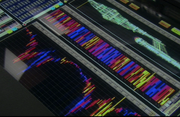
Also known as spectrometry, spectrography, or spectroscopic analysis, a spectrographic analysis was a process in sensor technology in which chemical elements were determined by measuring the wavelengths or spectral line intensity of a sample of matter. The wavelength or spectral line could be obtained by a form of excitation such as infrared.
In 2154, Enterprise NX-01 deduced that a debris cloud existed around a planet by creating a spectrographic analysis. Such an analysis was also used for detecting Klingon alloy as part of the hull plating. (ENT: "Observer Effect")
It was used by the geological lab aboard the USS Enterprise in 2254 to determine which elements would be encountered on the surface of Talos IV. Spectrographic scans determined in the preliminary lab survey that Talos had an oxygen-nitrogen atmosphere, with a surface heavy with inert elements. (TOS: "The Cage")
In 2265, Doctor Leonard McCoy had the lab run a bio-analysis on Enterprise crewmembers who had become infected with polywater intoxication. The lab's spectrography readings showed no contamination, nor any unusual elements. (TOS: "The Naked Time")
In 2266, a distant spectrograph on aboard the Enterprise detected the metallic signature of the Fesarius as it approached the Federation ship. (TOS: "The Corbomite Maneuver")
Spock ran a spectral analysis on the dead star Questar M-17, which revealed imploded matter. (TAS: "Beyond the Farthest Star")
Orion vessels emitted a unique trail of radioactive waste that was visible on a spectral analysis. (TAS: "The Pirates of Orion")
In 2364, when a transmitter on Geordi La Forge's VISOR was broadcasting a live feed, Captain Jean-Luc Picard interpreted a fissure in a bulkhead on the Batris as being like that a spectrograph of metal fatigue. La Forge confirmed the interpretation. (TNG: "Heart of Glory")
When Geordi La Forge tried to find out what caused the mysterious disappearance of his former crewmates of the USS Victory on Tarchannen III, he ran a spectrographic analysis, among other things. The analysis however was without results. (TNG: "Identity Crisis")
A full spectrographic analysis, run by Data, revealed that the Crystalline Entity that destroyed Melona IV in 2368 was the same creature that also devastated Omicron Theta in 2338. (TNG: "Silicon Avatar")
In 2369, when investigating a holosuite where Ibudan was murdered, Doctor Julian Bashir employed cellular spectrographs for finding trace matter left behind by the victim. Dr. Bashir findings, confirmed by Jadzia Dax, were that there was no new DNA traces in the suite. (DS9: "A Man Alone")
The USS Enterprise-D ran a spectrographic analysis on a Dyson sphere in 2369 to determine its structure and composition. (TNG: "Relics")
A spectroscopic analysis was included on the video of Miles O'Brien's supposed death on the space station above T'Lani III in 2370. It revealed that the liquid O'Brien was drinking late in the afternoon was coffee. Keiko O'Brien used this fact, combined with her intimate knowledge of her husband, to conclusively declare that the video had been forged, because, she averred, Miles never drank coffee that late in the day. (DS9: "Armageddon Game")
See also
- Bio-spectral analysis
- Hydrogen-alpha spectral analysis
- Spectral-line profile analysis
